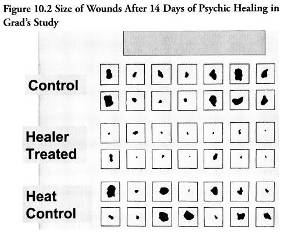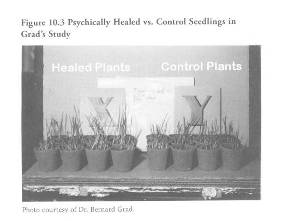
Chapter 10
* * *
PSYCHIC (nineteenth century English [origin: Greek “psukhikos,” of the mind or soul, from “psukhe,” psyche, noun; see “-ic”]): A person who is regarded as particularly susceptible to supernatural or paranormal influence; a medium, a clairvoyant.
HEAL (Old English): To free (a person) from disease or ailment, restore to health (now chiefly by miraculous, spiritual, or psychic means).—Shorter Oxford English Dictionary, 6th ed., s.v. “psychic” and “heal”
* * *
For many years, when talking about parapsychological findings, I referred to the “big four,” the four psi phenomena for which there was so much accumulated evidence that we could take them as the foundational findings of the field: three forms of ESP (telepathy, clairvoyance, and precognition), plus PK. Each had hundreds of well-controlled experiments supporting its existence. In the last two decades, though, enough positive studies of psychic healing have been published (see www.stephanaschwartz.com for an extensive, current bibliography, with abstracts) that I now speak of the “big five.” There are other apparent psi phenomena, which we’ll look at in later chapters, whose existence I’m not that certain about because they simply haven’t been researched enough, but these big five are solid and form a firm foundation for opening us to the spiritual possibilities of people.
Just as telepathy, clairvoyance, and precognition might turn out someday to be three aspects of some more basic psi ability for gathering information outside of the ordinary, material senses, our current conceptual separation of PK and psychic healing, as if they were two separate processes, might change. Perhaps it’s all one kind of psychic action or force, and we’re merely distinguishing whether the target is dead matter, calling it PK, or living matter, calling it psychic healing. Or maybe they’ll turn out to be quite distinct or perhaps aspects of something else whose existence we don’t even suspect yet.
Figure 9.1, the PK diagram in the previous chapter, can be used to model psychic healing too. The target is now some living system rather than a nonliving material like dice or electronic circuits.
In ordinary life, some people claim to be psychic healers, or are acclaimed by others to be healers, and all have success stories to tell, but ill people often get better on their own, so how do we know the success stories don’t really prove any special abilities of these healers? Or perhaps there’s a genuine healing effect that comes from a healer working on you, but it’s mediated by more ordinary physical and psychological factors, rather than psi factors, as we briefly discussed in chapter 2, when considering how you’d do experiments in this area? Knowing that someone cares about you tends to stimulate your immune system, for example. If that were all there was to psychic healing, it would still be wise to learn how to train such healers and figure out the most psychologically effective way for them to work, but that could be fitted within the materialistic worldview. How do we tell if there’s a psi component, a spiritual component?
For a firm basis, I like to lecture about the classical experimental work of biologist Bernard Grad, now retired, of McGill University. His was some of the pioneering, solid work that requires us to consider psychic healing as a reality.
Grad was a cancer researcher who got interested in psychic healing, especially when he met an immigrant to Canada, Oskar Estabany, who had a reputation as a healer. Estabany had discovered his gift when he was a soldier in the First World War. He was in charge of handling horses and seemed especially good at working with injured ones; they seemed to heal much quicker than they ordinarily would. He eventually found that his “laying on of hands” healing technique worked on people too, and developed a reputation as a healer.
Grad was aware of the psychological explanation of psychic healing mentioned above. If you were ill and someone was introduced to you as a healer, and then gave you a lot of careful attention and touching, you might well heal faster but simply as a matter of suggestion and placebo effects. Undoubtedly, this is useful clinically, but how could you test for a psychic component, a pure psi component of healing?
Clearly, it would help if you had “patients” who weren’t suggestible in the usual human meaning of the word. Grad carried out two classic studies (1965), one in which the “patients” were wounded barley seeds, the other in which the “patients” were wounded laboratory mice. Let’s look at the latter.
The laboratory mice were deliberately wounded by having a fold of their inherently loose skin plucked up and then a small chunk cut off with scissors. This produced a skin wound, which was a useful kind of illness to work with experimentally, because the size of the wound could be precisely measured by putting a piece of tracing paper over it and outlining the edges of the wound. Then a device called a planimeter could be used to objectively measure the actual area of the wound. Forty-eight mice were thus wounded and randomly assigned to three groups. The size of their wounds—the actual tracings—are shown in figure 10.1.

Aside from mental suggestion when people are the patients, we might conventionally hypothesize that the laying-on-of-hands healing might also involve some sort of chemicals emitted through the healer’s skin, chemicals that might have a healing effect. This would be useful to discover if it were indeed the case for some healers, but Grad wanted to isolate his mice patients from anything but a psi healing effect. Thus each mouse received an individual treatment, but to prepare for the treatment, a research assistant (who didn’t know what group the mice were to be in) would take a mouse from its cage, put it into a paper bag, and staple it shut so that the mouse was no longer handled directly. Few chemicals can readily penetrate a layer of dry paper in a short time.
Maybe just being put in a paper bag has an effect on a mouse? But all three groups of mice were put into paper bags.
For the experimental group, Estabany would then come in and hold the bagged mouse in the palms of his hands for twenty minutes twice a day, while visualizing the flow of healing energy. Estabany would leave the room, and then a research assistant would come in and put the mouse back in its cage, released from its paper bag. In the control group, once the mouse had been bagged, it sat on a shelf for the same amount of time Estabany gave healing treatments to the experimental mice. This controlled for being bagged per se.
The possibility also existed that the warmth of the healer’s hands could be responsible for promoting healing, so in the third “heat control” group, another assistant, not known to have any healing abilities, held the bagged mouse for the same length of time.
Grad had decided in advance that the degree of healing of the wounds, measured by how much they had closed up, would be measured after two weeks. Besides the statistical analysis of areas, which showed significant differences, figure 10.2 shows the wound sizes. It’s pretty clear to the naked eye that the controls and heat controls showed similar, moderate degrees of wound healing, but the experimental group treated by Estabany showed far more healing.

Grad’s other classic study involved using “wounded” barley seeds as “patients.” How do you wound a barley seed? You take a sack of them and put it in a hot oven for a while. Some of the seeds are killed by this procedure; all are partially damaged. You can then randomly separate the seeds to select your ill patients and randomly plant them in groups in a number of pots.
The healing treatment had to control for the fact that if you pray over plants, or otherwise hang out close to them, you’re increasing the carbon dioxide in the air, and that will stimulate their growth. Similarly the heat of your hands or possible chemicals from them might affect the plants or seedlings, so all these possibilities must be eliminated. This was done by never letting Estabany near the actual plants. Instead, for a healing session, Estabany would be given a hermetically sealed bottle of saline solution, the slightly salty water used for transfusions in hospitals. He would hold the sealed bottle between his hands for a while, give it a healing treatment, and then leave the room. Just to eliminate any problem with heat—a held bottle would get a little warmer in Estabany’s hands—the bottle was allowed to sit on a shelf so that it cooled back down to room temperature. Control bottles got no healing treatment from Estabany.
Why saline solution instead of just plain water? To keep the barley-seed patients under some stress, as an ill patient would be.
A research assistant, who was blind as to which sealed bottles had gotten a healing treatment and which hadn’t, later took the bottles and watered the pots containing the barley seeds. Thus some pots were consistently watered with “healed” water, others with control water.
At the end of a preset time, fourteen days, another research assistant, blind as to conditions, measured the heights of all the sprouted seeds, and then carefully dug them up and weighed them to see how much they had grown. A statistical analysis showed that the seeds treated with the healed water were significantly taller and weighed more, and more of them had sprouted.
Figure 10.3 shows the two groups of sprouted seedlings at the end of the fourteen days. The healed seedlings are on the left. Obviously, there’s a big difference, big enough to be practical, not merely statistically significant.

So when we describe some gardeners as having a green thumb, are we recognizing a possible psychic-healing ability, or growth-stimulating ability, aside from gardening technique?
In an interesting case study, Grad (1965) had some bottles of saline solution that had been held by a very depressed patient later used to water seedlings. Compared to controls, fewer sprouted; they weren’t as tall or as heavy. So there’s a black thumb, as well as a green thumb?
Larry Dossey, a physician and one of the world’s foremost experts on psychic healing once remarked to me on January 5, 2003, “You really do need to find a physician you can trust, if possible. I admire the Erma Bombeck rule: ‘Never go to a doctor whose plants have died.’”
Note that successful healers come from all traditions, so spiritual healing can be real, but it doesn’t prove the truth of any particular religion compared to other religions. This is a general principle applicable to all talents included in the big five and many maybes discussed in this book. They provide a support for spirituality in general but happen among followers of all sorts of religions and spiritual traditions, so there’s no point in getting caught up in a “My religion’s miracles are better than your religion’s miracles!” kind of mind-set.